poly
Makie.poly Function
poly(vertices, indices; kwargs...)
poly(points; kwargs...)
poly(shape; kwargs...)
poly(mesh; kwargs...)Plots a polygon based on the arguments given. When vertices and indices are given, it functions similarly to mesh. When points are given, it draws one polygon that connects all the points in order. When a shape is given (essentially anything decomposable by GeometryBasics), it will plot decompose(shape).
poly(coordinates, connectivity; kwargs...)Plots polygons, which are defined by coordinates (the coordinates of the vertices) and connectivity (the edges between the vertices).
Plot type
The plot type alias for the poly function is Poly.
Examples
using CairoMakie
using Makie.GeometryBasics
f = Figure()
Axis(f[1, 1])
poly!(Point2f[(0, 0), (2, 0), (3, 1), (1, 1)], color = :red, strokecolor = :black, strokewidth = 1)
f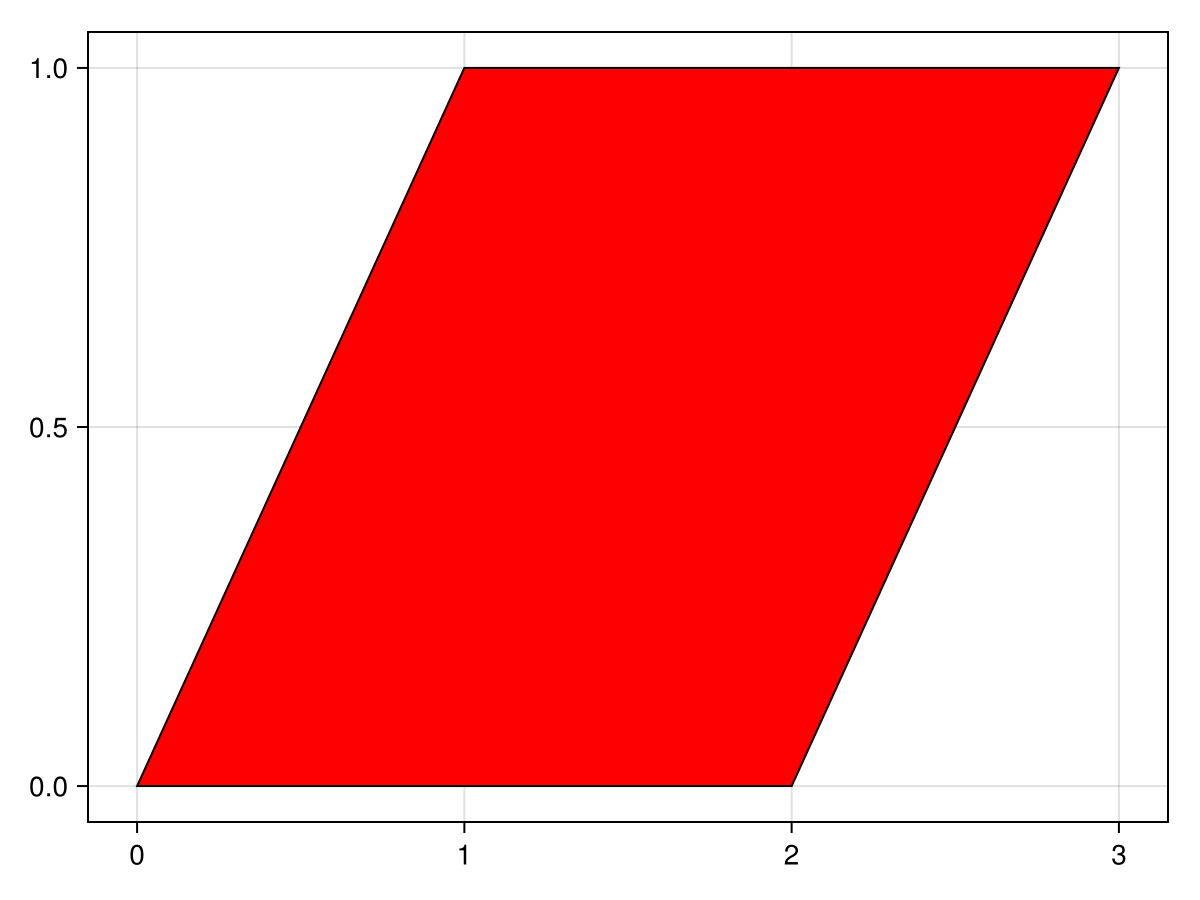
using CairoMakie
using Makie.GeometryBasics
f = Figure()
Axis(f[1, 1])
# polygon with hole
p = Polygon(
Point2f[(0, 0), (2, 0), (3, 1), (1, 1)],
[Point2f[(0.75, 0.25), (1.75, 0.25), (2.25, 0.75), (1.25, 0.75)]]
)
poly!(p, color = :blue)
f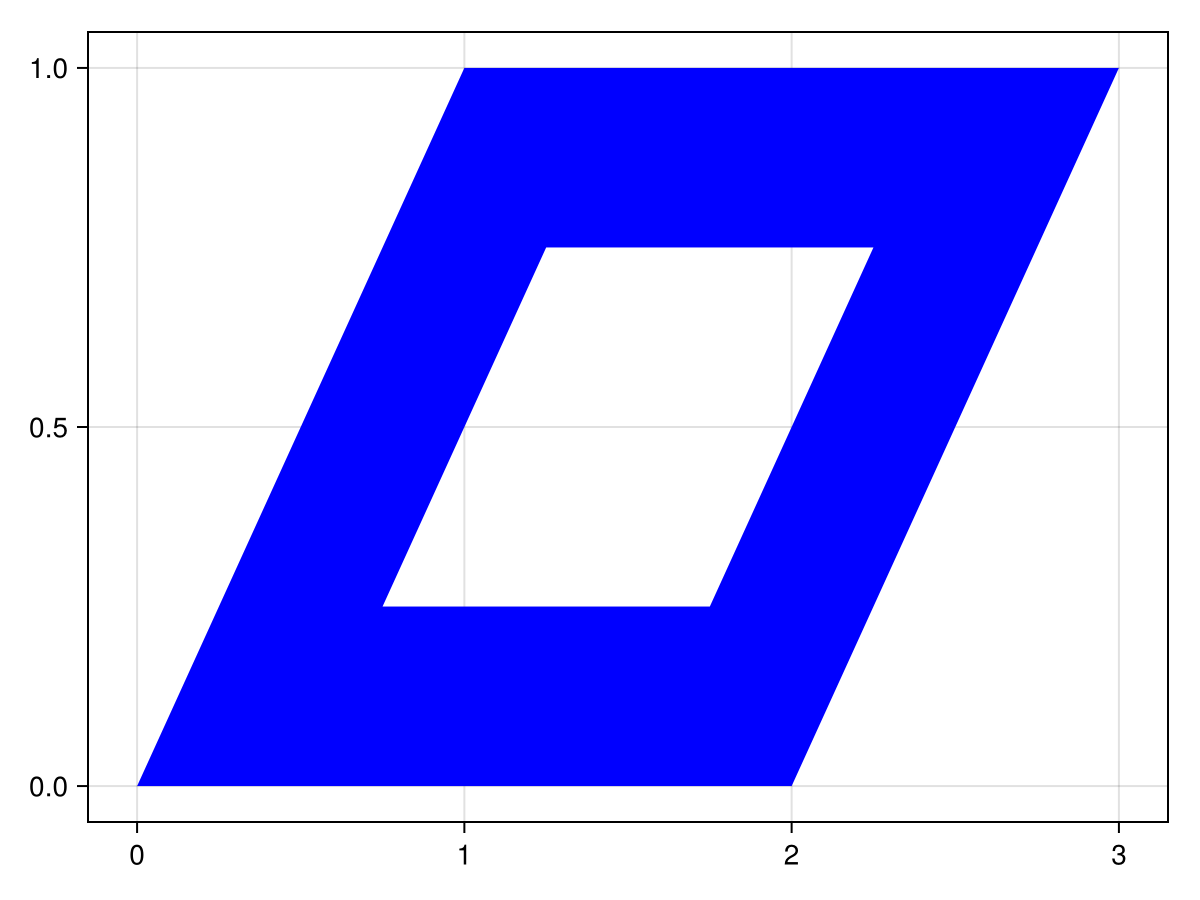
using CairoMakie
using Makie.GeometryBasics
f = Figure()
Axis(f[1, 1])
# vector of shapes
poly!(
[Rect(i, j, 0.75, 0.5) for i in 1:5 for j in 1:3],
color = 1:15,
colormap = :heat
)
f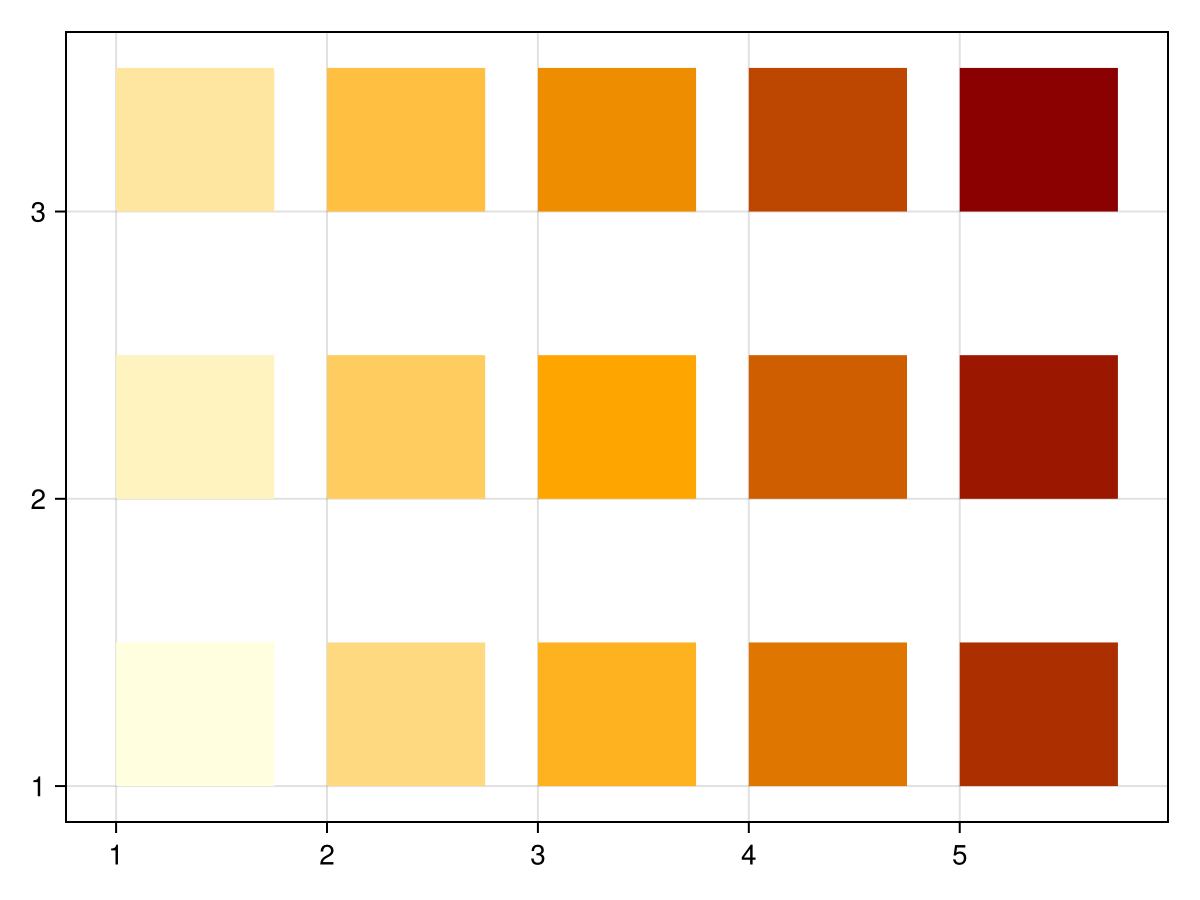
using CairoMakie
using Makie.GeometryBasics
f = Figure()
Axis(f[1, 1], aspect = DataAspect())
# shape decomposition
poly!(Circle(Point2f(0, 0), 15f0), color = :pink)
f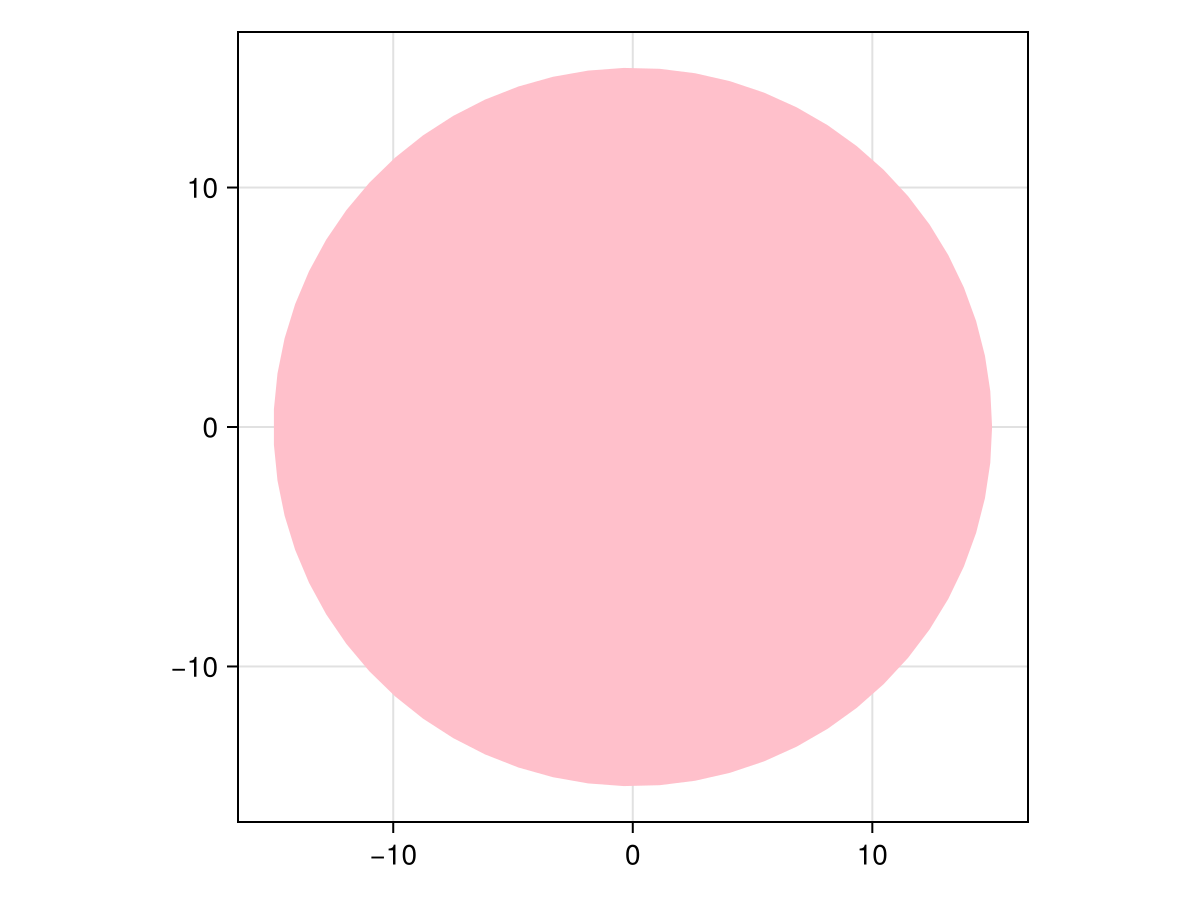
using CairoMakie
using Makie.GeometryBasics
f = Figure()
Axis(f[1, 1]; backgroundcolor = :gray15)
# vector of polygons
ps = [Polygon(rand(Point2f, 3) .+ Point2f(i, j))
for i in 1:5 for j in 1:10]
poly!(ps, color = rand(RGBf, length(ps)))
f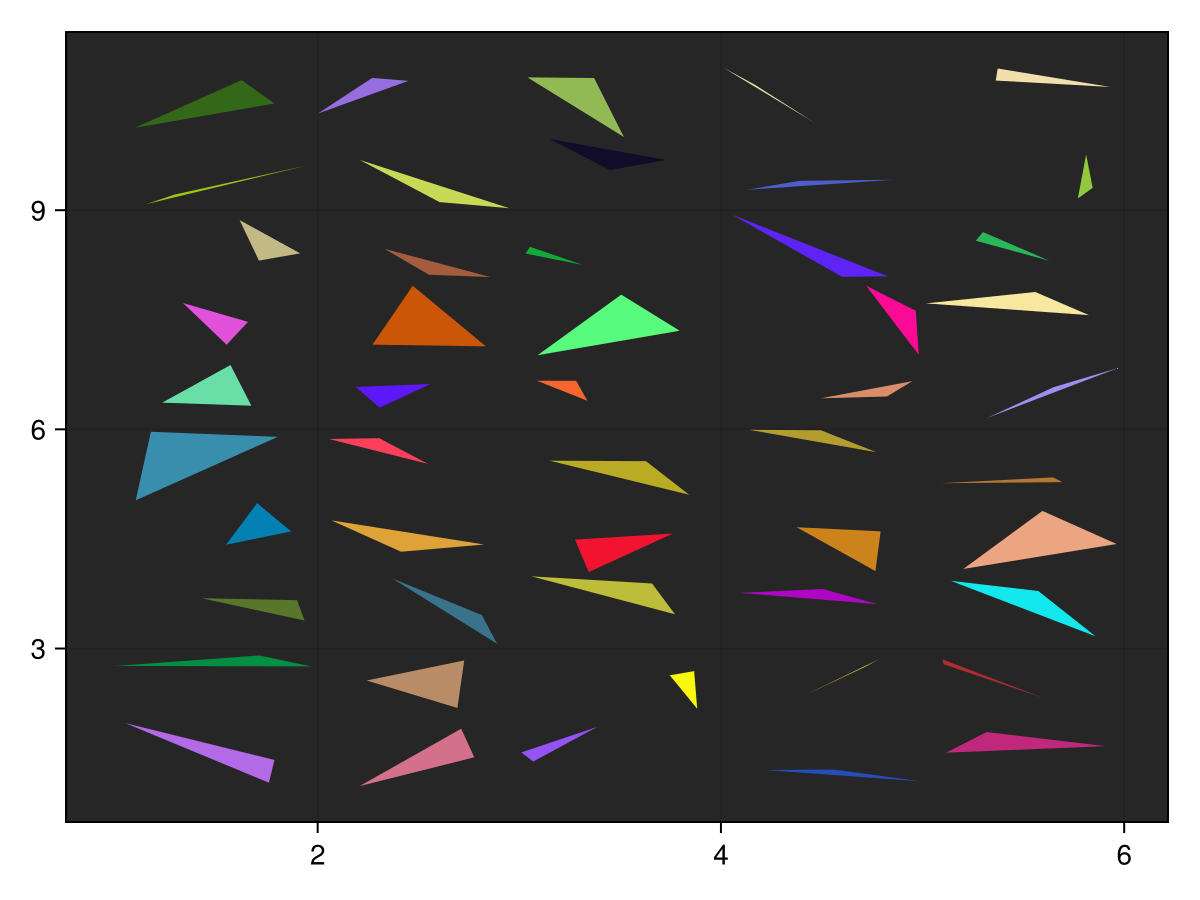
using CairoMakie
using Makie.GeometryBasics
f = Figure()
Axis(f[1, 1])
# vector of shapes
poly!(
[Rect(i, j, 0.75, 0.5) for i in 1:5 for j in 1:3],
color = :white,
strokewidth = 2,
strokecolor = 1:15,
strokecolormap=:plasma,
)
f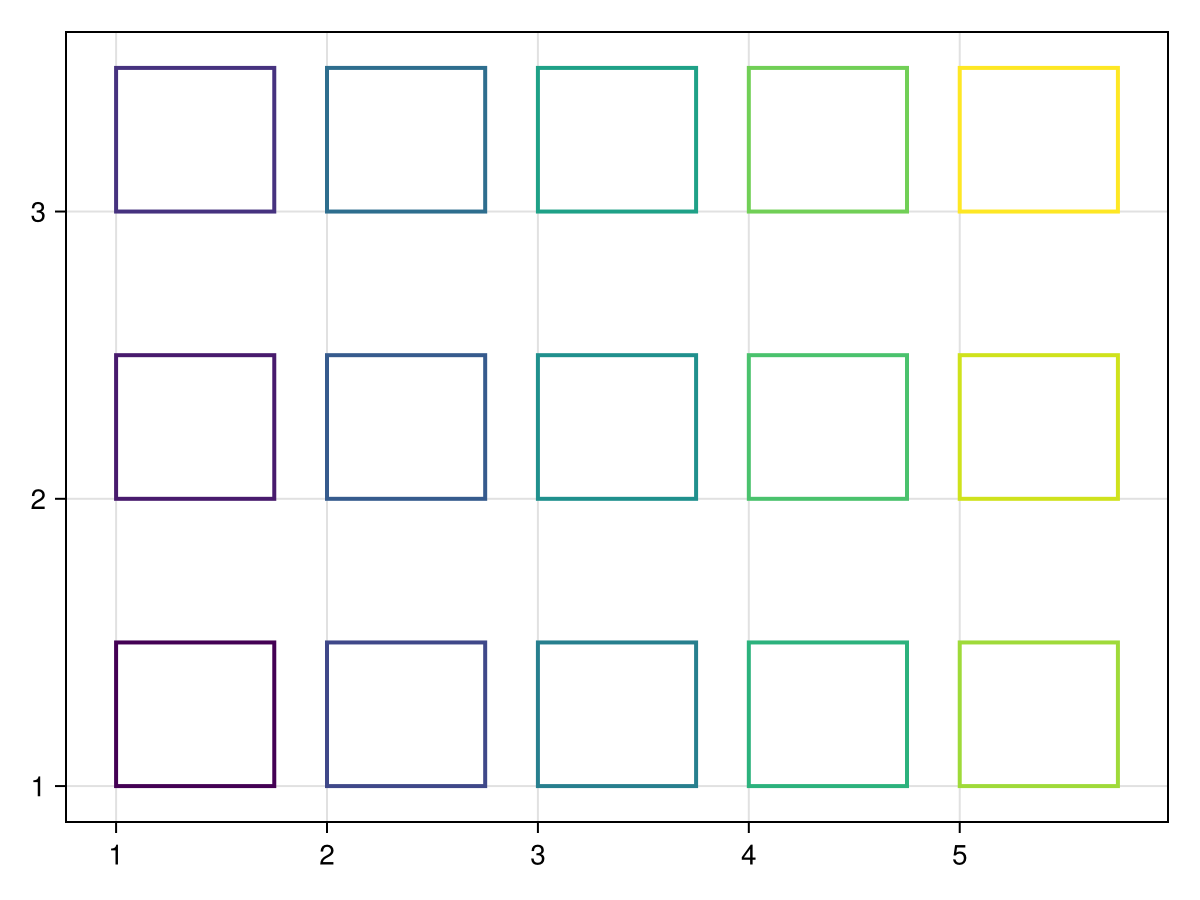
Attributes
alpha
Defaults to 1.0
The alpha value of the colormap or color attribute. Multiple alphas like in plot(alpha=0.2, color=(:red, 0.5), will get multiplied.
clip_planes
Defaults to @inherit clip_planes automatic
Clip planes offer a way to do clipping in 3D space. You can set a Vector of up to 8 Plane3f planes here, behind which plots will be clipped (i.e. become invisible). By default clip planes are inherited from the parent plot or scene. You can remove parent clip_planes by passing Plane3f[].
color
Defaults to @inherit patchcolor
Sets the color of the poly. Can be a Vector{<:Colorant} for per vertex colors or a single Colorant. A Matrix{<:Colorant} can be used to color the mesh with a texture, which requires the mesh to contain texture coordinates. Vector or Matrices of numbers can be used as well, which will use the colormap arguments to map the numbers to colors. One can also use a <: AbstractPattern, to cover the poly with a regular pattern, e.g. for hatching.
colormap
Defaults to @inherit colormap :viridis
Sets the colormap that is sampled for numeric colors. PlotUtils.cgrad(...), Makie.Reverse(any_colormap) can be used as well, or any symbol from ColorBrewer or PlotUtils. To see all available color gradients, you can call Makie.available_gradients().
colorrange
Defaults to automatic
The values representing the start and end points of colormap.
colorscale
Defaults to identity
The color transform function. Can be any function, but only works well together with Colorbar for identity, log, log2, log10, sqrt, logit, Makie.pseudolog10, Makie.Symlog10, Makie.AsinhScale, Makie.SinhScale, Makie.LogScale, Makie.LuptonAsinhScale, and Makie.PowerScale.
cycle
Defaults to [:color => :patchcolor]
Sets which attributes to cycle when creating multiple plots. The values to cycle through are defined by the parent Theme. Multiple cycled attributes can be set by passing a vector. Elements can
directly refer to a cycled attribute, e.g.
:colormap a cycled attribute to a palette attribute, e.g.
:linecolor => :colormap multiple cycled attributes to a palette attribute, e.g.
[:linecolor, :markercolor] => :color
depth_shift
Defaults to 0.0
Adjusts the depth value of a plot after all other transformations, i.e. in clip space, where -1 <= depth <= 1. This only applies to GLMakie and WGLMakie and can be used to adjust render order (like a tunable overdraw).
fxaa
Defaults to true
Adjusts whether the plot is rendered with fxaa (fast approximate anti-aliasing, GLMakie only). Note that some plots implement a better native anti-aliasing solution (scatter, text, lines). For them fxaa = true generally lowers quality. Plots that show smoothly interpolated data (e.g. image, surface) may also degrade in quality as fxaa = true can cause blurring.
highclip
Defaults to automatic
The color for any value above the colorrange.
inspectable
Defaults to @inherit inspectable
Sets whether this plot should be seen by DataInspector. The default depends on the theme of the parent scene.
inspector_clear
Defaults to automatic
Sets a callback function (inspector, plot) -> ... for cleaning up custom indicators in DataInspector.
inspector_hover
Defaults to automatic
Sets a callback function (inspector, plot, index) -> ... which replaces the default show_data methods.
inspector_label
Defaults to automatic
Sets a callback function (plot, index, position) -> string which replaces the default label generated by DataInspector.
joinstyle
Defaults to @inherit joinstyle
Controls the rendering of outline corners. Options are :miter for sharp corners, :bevel for "cut off" corners, and :round for rounded corners. If the corner angle is below miter_limit, :miter is equivalent to :bevel to avoid long spikes.
linecap
Defaults to @inherit linecap
Sets the type of line cap used for outlines. Options are :butt (flat without extrusion), :square (flat with half a linewidth extrusion) or :round.
linestyle
Defaults to nothing
Sets the dash pattern of the line. Options are :solid (equivalent to nothing), :dot, :dash, :dashdot and :dashdotdot. These can also be given in a tuple with a gap style modifier, either :normal, :dense or :loose. For example, (:dot, :loose) or (:dashdot, :dense).
For custom patterns have a look at Makie.Linestyle.
lowclip
Defaults to automatic
The color for any value below the colorrange.
miter_limit
Defaults to @inherit miter_limit
Sets the minimum inner join angle below which miter line joins truncate. See also Makie.miter_distance_to_angle.
model
Defaults to automatic
Sets a model matrix for the plot. This overrides adjustments made with translate!, rotate! and scale!.
nan_color
Defaults to :transparent
The color for NaN values.
overdraw
Defaults to false
Controls if the plot will draw over other plots. This specifically means ignoring depth checks in GL backends
shading
Defaults to false
Controls whether lights affect the polygon.
space
Defaults to :data
Sets the transformation space for box encompassing the plot. See Makie.spaces() for possible inputs.
ssao
Defaults to false
Adjusts whether the plot is rendered with ssao (screen space ambient occlusion). Note that this only makes sense in 3D plots and is only applicable with fxaa = true.
stroke_depth_shift
Defaults to -1.0e-5
Depth shift of stroke plot. This is useful to avoid z-fighting between the stroke and the fill.
strokecolor
Defaults to @inherit patchstrokecolor
Sets the color of the outline around a marker.
strokecolormap
Defaults to @inherit colormap
Sets the colormap that is sampled for numeric colors.
strokewidth
Defaults to @inherit patchstrokewidth
Sets the width of the outline.
transformation
Defaults to :automatic
Controls the inheritance or directly sets the transformations of a plot. Transformations include the transform function and model matrix as generated by translate!(...), scale!(...) and rotate!(...). They can be set directly by passing a Transformation() object or inherited from the parent plot or scene. Inheritance options include:
:automatic: Inherit transformations if the parent and childspaceis compatible:inherit: Inherit transformations:inherit_model: Inherit only model transformations:inherit_transform_func: Inherit only the transform function:nothing: Inherit neither, fully disconnecting the child's transformations from the parent
Another option is to pass arguments to the transform!() function which then get applied to the plot. For example transformation = (:xz, 1.0) which rotates the xy plane to the xz plane and translates by 1.0. For this inheritance defaults to :automatic but can also be set through e.g. (:nothing, (:xz, 1.0)).
transparency
Defaults to false
Adjusts how the plot deals with transparency. In GLMakie transparency = true results in using Order Independent Transparency.
visible
Defaults to true
Controls whether the plot gets rendered or not.